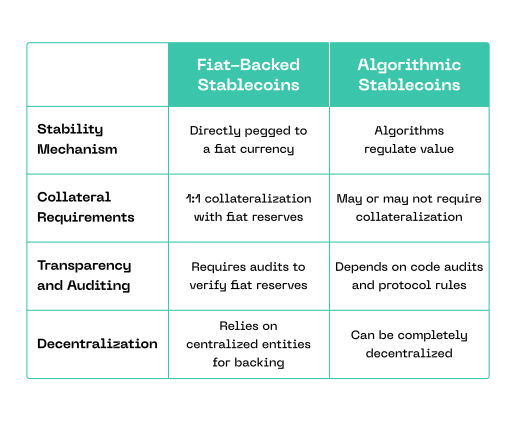In August 2023, the major payment platform PayPal announced it was launching a fiat-backed stablecoin. But PayPal was just the latest major financial player looking into the advantages that stablecoins can offer users, and the narrative around stablecoin tokens has only continued to grow.
As stablecoins grow in influence, two popular types of stablecoins that have emerged are fiat-backed stablecoins are and algorithmic stablecoins. Let's discuss how they work.
How Fiat-Backed Stablecoins Work
Stablecoins are cryptocurrencies designed to maintain a consistent value. This price stability is achieved by pegging the value of the cryptocurrency to another, more stable asset. Fiat-pegged stablecoins are backed to the value of a government-issued currency like the U.S. dollar, the Euro, or the Japanese yen.
Stablecoins maintain a 1:1 value ratio with their underlying fiat reserves. Stablecoin issuers collateralize the crypto tokens by holding an equivalent amount of fiat currency in reserve accounts. This ensures that fiat-backed stablecoins are always redeemable for their equivalent in fiat currency.
Some popular use cases for fiat-backed stablecoins are:
- Moving in and out of crypto trades
- Sending payments across borders
- Hedging against volatility
- Stable, non-fiat savings
What are Algorithmic Stablecoins?
An algorithmic stablecoin is a type of stablecoin designed to maintain price stability through dynamic mechanisms and algorithms rather than the value of another asset like fiat money. Because one of the original goals of crypto and blockchain was to provide alternatives to fiat, algorithmic stablecoins provide a way to maintain a consistent value without relying on government-backed currencies.
Algorithmic stablecoins use smart contracts to autonomously adjust their supply in response to market demand. When the coin's value rises, automated mechanisms can increase its supply, driving down the price. When it falls, the supply automatically contracts, pulling the price back to its baseline. This mechanism keeps the price stable without the need for collateral reserves.
Smart contracts manage the complex calculations, but there are also incentives for token holders to either buy or sell the stablecoin, depending on whether the price drifts high or low. As market conditions change, algorithms constantly recalculate how to maintain the target price.
Some popular use cases for algorithmic stablecoins are:
- DeFi applications like liquidity pools and pegged trading pairs
- Serving as an alternative to the fiat financial system
- Financial inclusion for the unbanked
- Stable, non-fiat savings
Comparing Fiat-Backed and Algorithmic Stablecoins
Ultimately, the two types of stablecoins we've covered are used for very similar things, but there are some key differences between the two.

Source: Trust Machines
Pros and cons of fiat-backed and algorithmic stablecoins
There are positives and negatives for both types of stablecoins, depending on who you ask. Some people prefer fiat-backed coins because they’re tied directly to a government-guaranteed asset.
This is useful, for example, when sending payments to another country. The transfer can be made without having to pay exorbitant exchange fees. On the other hand, many people argue that pegging cryptocurrency to fiat defeats the entire purpose of cryptocurrency.
Algorithmic stablecoins hold the promise of completely decentralized currencies that are not volatile like Bitcoin or Ethereum. However, some also argue that algorithmic stability is a gamble or doomed to fail — as was the case of the original Terra Luna stablecoin.
Examples of Popular Fiat-Backed and Algorithmic Stablecoins
Tethering the value of stablecoins to a specific value is meant to create a safe haven in the wider, more volatile crypto market. This has led to the creation of a number of stablecoins that have gained in popularity and amassed fairly significant market capitalizations over the years.
Some popular fiat-backed stablecoins include USD Coin (USDC) and Tether (USDT). Some examples of algorithmic stablecoins include Dai and TerraUSD (UST).
Additional types of stablecoins: crypto and commodity-backed stablecoins
Fiat-backed and algorithmic aren’t the only two types of stablecoins. There are also commodity-backed and crypto-backed stablecoins.
Stablecoins backed by commodities are pegged to the value of physical commodities like gold, oil, or other tangible assets. Their price is anchored to the value of the underlying commodity.
Crypto-backed stablecoins use other cryptocurrencies as collateral. They overcollateralize the supply with another cryptocurrency. This ensures the collateral's value always exceeds the stablecoin's value.
Conclusion: The Role of a Stablecoin in Crypto
Stablecoins, as a crypto asset, have become a critical part of the crypto industry. Many people use them to move between fiat and crypto or participate in decentralized finance. They’re also extremely useful for sending international payments and improving financial inclusion.
Fiat-backed stablecoins raise concerns about centralization but solidly maintain a consistent value. Algorithmic stablecoins promise the possibility of total decentralization, but they’re yet to be proven reliable in the long-term.
There is also controversy in the crypto community over whether stablecoins are opening the door for CBDCs (central bank digital currencies) created by nation states. A CBDC could potentially damage financial autonomy around the world, providing the opportunity for complete government control of citizens’ finances.
But regardless of the larger implications for government stablecoins, the financial services industry is quickly realizing the value of stablecoins. That’s why companies like PayPal are making unprecedented moves to create their own stablecoins. The world is beginning to see how crypto is transforming how we send, receive, and invest money.
Nearly any crypto transaction users make likely involves stablecoins somewhere along the way. The volatility of other types of crypto like BTC and ETH make them difficult to use for anything outside of investment speculation. But stablecoins open the door for a multitude of important digital currency use cases.

